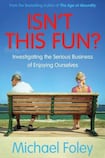
Here’s a a fun idea: a book about fun. The title cleverly captures the ambiguity sometimes found bouncing at the heart of the fun experience: the anxious question “Is this fun?” and the sometimes cajoling nature of “fun”, as in “Come on, this is fun.”
Michael Foley’s fun begins when he is on holiday in the US and an American’s mother offers him the chance to go sailing with her big blond American son. It’s an offer he can’t refuse because of the power of American insistence (though probably as much to do with a writer’s need of experiences from which to spin books). Once away from the jam-packed beach – the dubious locus of fun – the American asks: “Isn’t this fun?”
The author posits a humorously worrying question: “Imagine . . . becoming known as the the man who hates fun.” He feels he may be that man, and the book is partly an exploration of his place in the fun matrix. In part one, he sets about trying to define fun : “The first definite fact is that fun is a recent phenomenon. For all but the last few centuries of over 200,000 years on earth, Homo sapiens had no fun at all. This is not just because life was hard, although that was certainly the case, but because there was no such thing as fun.”

Was there really no fun before the invention of the word “fun”? Were there no giddy interludes – moments of cave humour – as they ran from mammoths and maybe Arrgh’s fur got snagged on a tree and he ran on naked?
Such a questionable claim points to a certain lack of rigour in places in this book, a slight vagueness now and again in a text that is peppered by many “may haves”, “most likelies” and “probablies”.
However, there is much to enjoy in a book of great scope that is light in tone but serious in content.
Modern concept
In part two, Foley tries to understand fun through chapters headed “Fun and Ritual”, “Fun and Transcendence” and “Fun and the Group”. (Foley does like a list, so I thought I’d partake myself.)
Although he defines fun as a modern concept, he identifies it again and again as a return to the oldest rituals of prehistory. This historical mapping is repeated through each chapter.
This history often follows a similar path, as in the chapter on dancing: pagan ritual gives way to Christianity, which steps in and co-opts it, and eventually (in a two-step move) Christianity steps in again and stamps it out. Foley identifies this as, ultimately, the elite – the higher level – quashing the fun of the lower-level people.
It's apt that Rabelais makes an appearance in the book as within this one author the two levels – "higher" and "lower" – come together. According to Foley, Rabelais understands "that the thinker who argues against religion, politics and philosophy is basically an organism whose primary need is to ingest and excrete . . ." There are some hilarious excerpts from Rabelais's novel Gargantua and Pantagruel and it is one of the pleasures of the book that subjects point the way to further reading, whether it's writers such as Terry Southern, Comte de Lautréamont, or philosophers such as Debord.
In "Fun and the Group", Foley posits: "It's not so much that there are groups in order to enjoy fun as that there is fun in order to enjoy groups." There is an interesting exploration of group dynamics – from his own college days as part of a trio of friends to a look at the modern urban tribe as epitomised by the sitcom Friends.
The optimum number for a group seems to be three or multiples of. Twelve is a key number, while a viable group has an upper limit of about 150 because “the human brain can just about maintain personal relationships with 150 people or so”. Foley quotes research providing evidence of such an optimum number existing right back through history, as far back as the hunter-gatherer communities of our ancestors.
In part three, Foley explores fun through specific activities in sections such as “Fun Goes Comical” and “ Fun Goes Political” (these two are particularly good). In the comedy part, he goes to shows and writes perceptive critiques of both beginners (and the brutality of their failure to get laughs) and more professional comics. Particularly interesting are his observations on the deconstructive comic John Kearns, who deliberately plays with the idea of failure. Foley skips from Grimaldi to Dickens to Rabelais to Richard Pryor. He posits a lineage from the “shaman, trickster, Lord of Saturn, Lord of Misrule, jester, Harlequin, clown and stand-up comedian”.
By the end of the book, he has come to an understanding that “The suspicion that much of my aversion to to fun was intellectual snobbery has been confirmed. I understand now that the individualism I believed to be the terminus of Western civilisation may be merely a short-term aberration.” But he admits that “this is unlikely to change my behaviour at this stage”.
In keeping with his realisation of the source of his aversion to fun, this book is an entertaining mix of the academic, the YouTube, insightful observation, jokes (sometimes bad), interesting commentary, journalistic reportage (as he participates in various events), and philosophising. And for deeper delving you can check out the fantastic bibliography. Kevin Gildea is a comedian and critic










